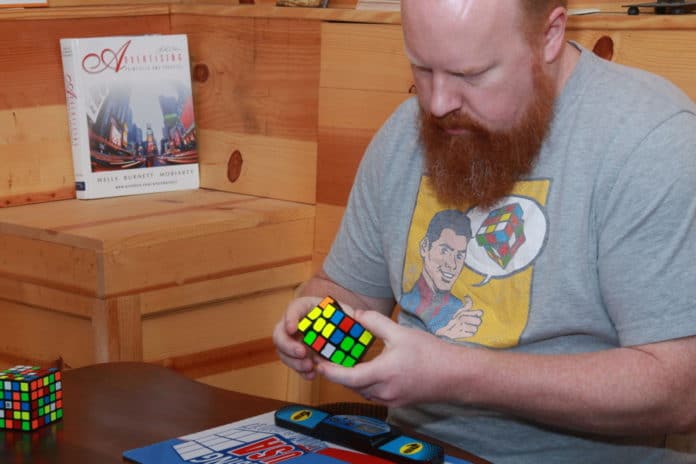If you remember the Rubik’s Cube from its time as a fad in the 1980s, you may be surprised to learn it’s not only still around, but there is a “speedcubing” community where people solve the puzzle – along with others – as a competition.
Invented by Hungarian sculptor and professor of architecture Emo Rubick in 1974, more than 350 million have been sold worldwide.
Our correspondent Rick Mauch has a report on a local speedsolver.
For a couple decades Jason Green was an avid bowler. Now, he’s bowling people over with his current hobby.
Green is a speedsolver. His specialty is the Rubik’s Cube, which he has solved in as little as 11.019 seconds.
“There is a misconception you need to be a genius to be a cuber. Anyone who has a little determination can learn,” he said. “I think it would be more accurate to say that us nerdy/geeky types tend to be attracted to cubing in the first place. But I would really encourage anyone who thinks they might like it to give it a try.”
Green got into what he calls “proper” speedsolving in July 2016. However, he has had an appreciation for the Rubik’s Cube since he was a child.
When the cube first became popular in the 1980s he and his brother would work together to solve one. They mastered the concept of solving one face, which is one side of the cube being the same color.
Then, while driving down the road a couple of years ago, Green heard a song that reminded him of those younger days and inspired him to pick up a cube again.
“It was actually when the country song 19 Somethin’ came out that I decided to learn to solve,” he said. “I was driving and heard the song mention the Rubik’s cube. I thought to myself, ‘Hey you can learn anything online now. I should look up how to solve that.'”
And so he did, studying the technique of former Swedish champion Lars Petrus. However, Green was nowhere as fast at solving the cube as he is today.
Green did more research, some of which, he said, “blew my mind” as people were solving the cube in as little as 20 seconds. He looked at his old-style cube that was hard to turn and realized it was time to become serious about his hobby and get a smoother, more modern cube.
“From the videos I was seeing, it was clear they had far superior cubes on the market, so I did what any American would do and searched Amazon Prime,” he said.
Though it is a sport mostly for young people, Green says, he didn’t begin competing until he was 40.
“It’s hard to explain all the reasons I love to cube so much. I often tell people the two reasons I picked it up was to help my memory, and to show off,” he said. “But there’s something much more to it that I enjoy. It’s relaxing. It’s exciting. It’s rewarding to see yourself improve.
Green competed in his first national tournament this year in Fort Wayne, Indiana. The event featured 800 competitors and Green qualified in four categories.
In his non-cube life, Green is a software engineer for BNSF. He finds a connection between his profession and his affinity for solving a cube.
“I think the connection is in enjoying solving things. I definitely feel a similar self-accomplishment with a computer program and a cube,” he said. “They are both things you know beforehand can be overcome if you invest in it, and it’s rewarding when you meet that goal. Also, on the older cubers there is a very large percentage of us involved with software, so I think it’s the right type of mindset to enjoy cubing.”
Green also solves other puzzles, including metallic intertwined ones, Sudoku, and of course crosswords. As much as he loves competing, Green loves the therapeutic side to speedsolving.
The world record for solving a Rubik’s Cube is 4.73 seconds, set last year by Feliks Zemdegs of Australia. For years, the world record of 20 seconds stood, but people are getting faster, particularly since the founding of the World Cube Association in 1999.
The sport became popular in Texas in 2008 thanks to a group at the University of Texas in Austin.
Green is working to expand that community. He heads a group that meets at the Euless Public Library on the first and third Monday of each month at 6:30 p.m.
Robert Francis is editor of the Fort Worth Business Press.






